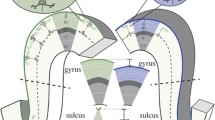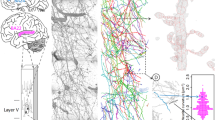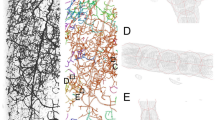Abstract
Recent studies (Prabakaran et al. in Mol Psychiat 9:684–697, 2004; Hanson and Gottesman in BMC Med Genet 6:7, 2005; Harris et al. in PLoS ONE 3:e3964, 2008) have suggested that microvascular abnormalities occur in the brains of patients with schizophrenia. To assess the integrity of the microvasculature in subcortical brain regions in schizophrenia, we investigated the microvessel length density, total microvessel length, and microvessel length per neuron using design-based stereologic methods in the caudate nucleus, putamen, nucleus accumbens, mediodorsal nucleus of the thalamus, and lateral nucleus of the amygdala in both hemispheres of 13 postmortem brains from male patients with schizophrenia and 13 age-matched male controls. A general linear model multivariate analysis of variance with diagnosis and hemisphere as fixed factors and illness duration (patients with schizophrenia) or age (controls), postmortem interval and fixation time as covariates showed no statistically significant differences in the brains from the patients with schizophrenia compared to the controls. These data extend our earlier findings in prefrontal cortex area 9 and anterior cingulate cortex area 24 from the same brains (Kreczmanski et al. in Acta Neuropathol 109:510–518, 2005), that alterations in microvessel length density, total length, and particularly length per neuron cannot be considered characteristic features of schizophrenia. As such, compromised brain metabolism and occurrence of oxidative stress in the brains of patients with schizophrenia are likely caused by other mechanisms such as functional disruption in the coupling of cerebral blood flow to neuronal metabolic needs.






Similar content being viewed by others
References
Andreasen NC, Rezai K, Alliger R et al (1992) Hypofrontality in neuroleptic-naive patients and in patients with chronic schizophrenia. Assessment with xenon 133 single-photon emission computed tomography and the Tower of London. Arch Gen Psychiatry 49:943–958
Arnold SE, Trojanowski JQ (1996) Recent advances in defining the neuropathology of schizophrenia. Acta Neuropathol 92:217–231
Baborie A, Kuschinksy W (2006) Lack of relationship between cellular density and either capillary density or metabolic rate in different regions of the brain. Neurosci Lett 404:20–22
Barch DM, Mathews JR, Buckner RL et al (2003) Hemodynamic responses in visual, motor, and somatosensory cortices in schizophrenia. Neuroimage 20:1884–1893
Basu S, Nagy JA, Pal S et al (2001) The neurotransmitter dopamine inhibits angiogenesis induced by vascular permeability factor/vascular endothelial growth factor. Nat Med 7:569–574
Beckmann H, Lauer M (1997) The human striatum in schizophrenia. II. Increased number of striatal neurons in schizophrenics. Psychiatry Res 68:99–109
Berman KF, Zec RF, Weinberger DR (1986) Physiologic dysfunction of dorsolateral prefrontal cortex in schizophrenia. II. Role of neuroleptic treatment, attention, and mental effort. Arch Gen Psychiatry 43:126–135
Bogerts B (1984) Zur Neuropathologie der Schizophrenien. Fortschr Neurol Psychiatr 52:428–437
Braak H, Braak E (1983) Neuronal types in the basolateral amygdaloid nuclei of man. Brain Res Bull 11:349–365
Brambilla P, Cerini R, Fabene PF et al (2007) Assessment of cerebral blood volume in schizophrenia: a magnetic resonance imaging study. J Psychiatr Res 41:502–510
Brockhaus H (1942) Zur feineren Anatomie des Septum und des Striatum. J Psychol Neurol 5:1–56
Byne W, Buchsbaum MS, Mattiace LA et al (2002) Postmortem assessment of thalamic nuclear volumes in subjects with schizophrenia. Am J Psychiatry 159:59–65
Calhoun ME, Mouton PR (2000) Length measurement: new developments in neurostereology and 3D imagery. J Chem Neuroanat 21:257–265
Casanova MF, de Zeeuw L, Switala A et al (2005) Mean cell spacing abnormalities in the neocortex of patients with schizophrenia. Psychiatry Res 133:1–12
Catafau AM, Parellada E, Lomena FJ et al (1994) Prefrontal and temporal blood flow in schizophrenia: resting and activation Technetium-99 m-HMPAO-SPECT patterns in young neuroleptic-naive patients with acute disease. J Nucl Med 35:935–941
Cohen BM, Yurgelun-Todd D, English CD et al (1995) Abnormalities of regional distribution of cerebral vasculature in schizophrenia detected by dynamic susceptibility contrast MRI. Am J Psychiatry 152:1801–1803
Cullen TJ, Walker MA, Parkinson N et al (2003) A postmortem study of the mediodorsal nucleus of the thalamus in schizophrenia. Schizophr Res 60:157–166
Danos P, Schmidt A, Baumann B et al (2005) Volume and neuron number of the mediodorsal thalamic nucleus in schizophrenia: a replication study. Psychiatry Res 140:281–289
Davis KL, Stewart DG, Friedman JI et al (2003) White matter changes in schizophrenia: evidence for myelin-related dysfunction. Arch Gen Psychiatry 60:443–456
Dewulf A (1971) Anatomy of the normal human thalamus: topometry and standardized nomenclature. Elsevier, Amsterdam
Dorph-Petersen KA, Pierri JN, Sun Z et al (2004) Stereological analysis of the mediodorsal thalamic nucleus in schizophrenia: volume, neuron number, and cell types. J Comp Neurol 472:449–462
Farkas E, Donka G, de Vos RA et al (2004) Experimental cerebral hypoperfusion induces white matter injury and microglial activation in the rat brain. Acta Neuropathol 108:57–64
Franzen G, Ingvar DH (1975) Absence of activation in frontal structures during psychological testing of chronic schizophrenics. J Neurol Neurosurg Psychiatry 38:1027–1032
Gundersen HJG (2002) Stereological estimation of tubular length. J Microsc 207:155–160
Hakak Y, Walker JR, Li C et al (2001) Genome-wide expression analysis reveals dysregulation of myelination-related genes in chronic schizophrenia. Proc Natl Acad Sci USA 98:4746–4751
Hanson DR, Gottesman II (2005) Theories of schizophrenia: a genetic-inflammatory-vascular synthesis. BMC Med Genet 6:7
Harris LW, Wayland M, Lan M et al (2008) The cerebral microvasculature in schizophrenia: a laser capture microdissection study. PLoS ONE 3:e3964
Harrison PJ (1999) The neuropathology of schizophrenia. A critical review of the data and their interpretation. Brain 122:593–624
Harrison PJ, Owen MJ (2003) Genes for schizophrenia? Recent findings and their pathophysiological implications. Lancet 361:417–419
Harrison PJ, Weinberger DR (2005) Schizophrenia genes, gene expression, and neuropathology: on the matter of their convergence. Mol Psychiatry 10:40–68
Heinsen H, Heinsen YL (1991) Serial thick, frozen, gallocyanin stained sections of human central nervous system. J Histotechnol 14:167–173
Heinsen H, Rub U, Bauer M et al (1999) Nerve cell loss in the thalamic mediodorsal nucleus in Huntington’s disease. Acta Neuropathol 97:613–622
Hill K, Mann L, Laws KR et al (2004) Hypofrontality in schizophrenia: a meta-analysis of functional imaging studies. Acta Psychiatr Scand 110:243–256
Hirai T, Jones EG (1989) A new parcellation of the human thalamus on the basis of histochemical staining. Brain Res Rev 14:1–34
Hof PR, Haroutunian V, Copland C et al (2002) Molecular and cellular evidence for an oligodendrocyte abnormality in schizophrenia. Neurochem Res 27:1193–1200
Hof PR, Haroutunian V, Friedrich VL Jr et al (2003) Loss and altered spatial distribution of oligodendrocytes in the superior frontal gyrus in schizophrenia. Biol Psychiatry 53:1075–1085
Holt DJ, Herman MM, Hyde TM et al (1999) Evidence for a deficit in cholinergic interneurons in the striatum in schizophrenia. Neuroscience 94:21–31
Ingvar DH, Franzen G (1974) Distribution of cerebral activity in chronic schizophrenia. Lancet 2:1484–1486
Iwamoto K, Bundo M, Kato T (2005) Altered expression of mitochondria-related genes in postmortem brains of patients with bipolar disorder or schizophrenia, as revealed by large-scale DNA microarray analysis. Hum Mol Genet 14:241–253
Jones EG (1997) A description of the human thalamus. In: Steriade M, Jones EG, McCormick DA (eds) Thalamus, vol II. Experimental and clinical aspects. Elsevier Science, Oxford, pp 425–500
Kety SS (1959) Biochemical theories of schizophrenia. I. Science 129:1528–1532
Kety SS (1959) Biochemical theories of schizophrenia. II. Science 129:1590–1596
Khaitovich P, Lockstone HE, Wayland MT et al (2008) Metabolic changes in schizophrenia and human brain evolution. Genome Biol 9:R124
Kim HJ, Koh PO, Kang SS et al (2001) The localization of dopamine D2 receptor mRNA in the human placenta and the anti-angiogenic effect of apomorphine in the chorioallantoic membrane. Life Sci 68:1031–1040
Kreczmanski P, Schmidt-Kastner R, Heinsen H et al (2005) Stereological studies of capillary length density in the frontal cortex of schizophrenics. Acta Neuropathol 109:510–518
Kreczmanski P, Heinsen H, Mantua V et al (2007) Volume, neuron density, and total neuron number in five subcortical regions in schizophrenia. Brain 130:678–692
Krimer LS, Muly EC 3rd, Williams GV et al (1998) Dopaminergic regulation of cerebral cortical microcirculation. Nat Neurosci 1:286–289
Lauer M, Heinsen H (1996) Cytoarchitectonics of the human nucleus accumbens. J Hirnforsch 37:243–254
Lauer M, Beckmann H (1997) The human striatum in schizophrenia. I. Increase in overall relative striatal volume in schizophrenics. Psychiatry Res 68:87–98
Lauer M, Senitz D, Beckmann H (2001) Increased volume of the nucleus accumbens in schizophrenia. J Neural Transm 108:645–660
Lewis DA, Lewitt P (2002) Schizophrenia as a disorder of neurodevelopment. Annu Rev Neurosci 25:409–432
Li JZ, Vawter MP, Walsh DM et al (2004) Systematic changes in gene expression in postmortem human brains associated with tissue pH and terminal medical conditions. Hum Mol Genet 13:609–616
Malaspina D, Harkavy-Friedman J, Corcoran C et al (2004) Resting neural activity distinguishes subgroups of schizophrenia patients. Biol Psychiatry 56:931–937
Meyer-Lindenberg A, Miletich RS, Kohn PD et al (2002) Reduced prefrontal activity predicts exaggerated striatal dopaminergic function in schizophrenia. Nat Neurosci 5:267–271
Middleton FA, Mirnics K, Pierri JN et al (2002) Gene expression profiling reveals alterations of specific metabolic pathways in schizophrenia. J Neurosci 22:2718–2729
Mouton PR, Gokhale AM, Ward NL et al (2002) Stereological length estimation using spherical probes. J Microsc 206:54–64
Mueser KT, McGurk SR (2004) Schizophrenia. Lancet 363:2063–2072
Pakkenberg B (1990) Pronounced reduction of total neuron number in mediodorsal thalamic nucleus and nucleus accumbens in schizophrenics. Arch Gen Psychiatry 47:1023–1028
Popken GJ, Bunney WE, Potkin SG et al (2000) Subnucleus-specific loss of neurons in medial thalamus of schizophrenics. Proc Natl Acad Sci USA 97:9276–9280
Prabakaran S, Swatton JE, Ryan MM et al (2004) Mitochondrial dysfunction in schizophrenia: evidence for compromised brain metabolism and oxidative stress. Mol Psychiatry 9:684–697
Schmidt-Kastner R, van Os J, WM Steinbusch H et al (2006) Gene regulation by hypoxia and the neurodevelopmental origin of schizophrenia. Schizophr Res 84:253–271
Schmitz C, Hof PR (2005) Design-based stereology in neuroscience. Neuroscience 130:813–831
Schultz SK, O’Leary DS, Boles Ponto LL et al (2002) Age and regional cerebral blood flow in schizophrenia: age effects in anterior cingulate, frontal, and parietal cortex. J Neuropsychiatry Clin Neurosci 14:19–24
Schumann CM, Amaral DG (2005) Stereological estimation of the number of neurons in the human amygdaloid complex. J Comp Neurol 491:320–329
Siever LJ, Davis KL (2004) The pathophysiology of schizophrenia disorders: perspectives from the spectrum. Am J Psychiatry 161:398–413
Sims KS, Williams RS (1990) The human amygdaloid complex: a cytologic and histochemical atlas using Nissl, myelin, acetylcholinesterase and nicotinamide adenine dinucleotide phosphate diaphorase staining. Neuroscience 36:449–472
Sorvari H, Soininen H, Pitkanen A (1996) Calbindin-D28K-immunoreactive cells and fibres in the human amygdaloid complex. Neuroscience 75:421–443
Teunis MA, Kavelaars A, Voest E (2002) Reduced tumor growth, experimental metastasis formation, and angiogenesis in rats with a hyperreactive dopaminergic system. FASEB J 16:1465–1467
Tkachev D, Mimmack ML, Ryan MM et al (2003) Oligodendrocyte dysfunction in schizophrenia and bipolar disorder. Lancet 362:798–805
Tomita H, Vawter MP, Walsh DM et al (2004) Effect of agonal and postmortem factors on gene expression profile: quality control in microarray analyses of postmortem human brain. Biol Psychiatry 55:346–352
Tsuang M (2000) Schizophrenia: genes and environment. Biol Psychiatry 47:210–220
Vawter MP, Tomita H, Meng F et al (2006) Mitochondrial-related gene expression changes are sensitive to agonal-pH state: implications for brain disorders. Mol Psychiatry 615:663–679
Webster MJ, Knable MB, Johnston-Wilson N et al (2001) Immunohistochemical localization of phosphorylated glial fibrillary acidic protein in the prefrontal cortex and hippocampus from patients with schizophrenia, bipolar disorder, and depression. Brain Behav Immunol 15:388–400
Weinberger DR, Berman KF, Zec RF (1986) Physiologic dysfunction of dorsolateral prefrontal cortex in schizophrenia. I. Regional cerebral blood flow evidence. Arch Gen Psychiatry 43:114–124
Young KA, Manaye KF, Liang C et al (2000) Reduced number of mediodorsal and anterior thalamic neurons in schizophrenia. Biol Psychiatry 47:944–953
Acknowledgments
We thank E.K. Broschk and H. Steinbusch for expert technical assistance, Dr. M. Schüler (Bayreuth, Germany) for valuable help in retrieving clinical data of the investigated patients, and G. Greene and B. Boehringer (MicroBrightField, Williston, VT, USA) for valuable help in implementing the space balls method. This work was supported by the Stanley Medical Research Institute (#02R-258, #04R-674 to HH, PRH, and CS), the European Community (Quality of Life and Management of Living Resources, QLK6-CT-2000-60042, QLK6-GH-00-60042-46, to PK), and NIH grant MH66392 to PRH.
Author information
Authors and Affiliations
Corresponding authors
Rights and permissions
About this article
Cite this article
Kreczmanski, P., Heinsen, H., Mantua, V. et al. Microvessel length density, total length, and length per neuron in five subcortical regions in schizophrenia. Acta Neuropathol 117, 409–421 (2009). https://doi.org/10.1007/s00401-009-0482-7
Received:
Revised:
Accepted:
Published:
Issue Date:
DOI: https://doi.org/10.1007/s00401-009-0482-7




